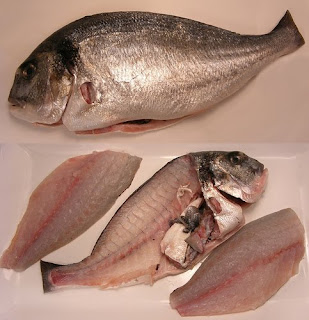AQUACULTURE
Fish learning to catch themselves
Plan is being tested to use sound to train fish to swim into harvesting areas.
ASSOCIATED PRESS
Sunday, March 30, 2008
BOSTON — Call them Pavlov's fish: Scientists are testing a plan to train fish to catch themselves by swimming into a net when they hear a tone that signals feeding time.
If it works, the system could eventually allow black sea bass to be released into the open ocean, where they would grow to market size, then swim into an underwater cage to be harvested when they hear the signal.
"It sounds crazy, but it's real," said Simon Miner, a research assistant at the Marine Biological Laboratory at Wood's Hole, which received a $270,000 grant for the project from the National Oceanic and Atmospheric Administration.
Miner said specially trained fish might one day be used to bolster the depleted black sea bass stock.
The bigger goal is to defray the costs of fish farming, an increasingly important source of the world's seafood. If fish can be trained to return to the farmer after feeding in the open ocean for several days, farms could save money on feed and reduce the amount of fish waste released in concentrated areas.
Randy MacMillan, president of the National Aquaculture Association, said fish farmers won't be easily persuaded to adopt open-ocean ranching. There are questions about how many fish would be lost to predators or how many might simply swim away.
"The commercial side is going to be skeptical," said MacMillan, who works on a trout farm in Idaho.
The project is one of several aquaculture experiments financed by the federal government last year. "We're looking for innovations that will actually make a difference for coastal communities and the environment," said Michael Rubino, the agency's aquaculture manager. "It fits in both."
Past experiments have used sound to train a fish to feed — similar to what Russian scientist Ivan Pavlov did with his famous dogs that salivated at the sound of a bell, expecting food.
In Japan, scientists have used sound to keep newly released farmed fish in certain areas, where they could be caught in traditional ways.
But no one has ever tried to get fish to leave and return to an enclosure where they can be scooped up.
The project began last summer using 6,500 black sea bass, a bottom-dwelling fish that lives between Florida and Cape Cod.
The species grows up to 3 pounds and 20 inches long and has a thick, white flesh that can be filleted for broiling or cut into nuggets for frying.
Miner said the first objective was to see whether the fish could truly be trained. He got his answer after keeping the fish in a circular tank and then sounding a tone before he dropped food in an enclosed "feeding zone" within the tank that the fish could enter only through a small opening.
Researchers played the tone for 20 seconds, three times a day, for about two weeks. Afterward, whenever the tone sounded, "you have remote-control fish," Miner said. "You hit that button, and they go into that area, and they wait patiently."
Miner is now trying to figure out how long fish remember to associate the tone with food. He feeds the fish outside the feeding zone without a tone for a few days and then tests if they will still go to the feeding area when the tone sounds again.
Some fish forgot after five days. Others remembered for as long as 10 days. Miner said the strength of memory seems tied to how long the fish are trained.
By May, researchers say, they hope to bring about 5,000 black sea bass to a feeding station called an AquaDome, a structure about 33 feet across and 16 feet high that will be anchored to the ocean floor in Buzzards Bay, 45 miles southeast of Boston.
The sea bass will be fed in the dome after a tone sounds. After researchers decide that they've been sufficiently trained, the fish will be freed from the dome. A day or two later, scientists will sound the tone and see how many bass return.
They'll do the experiment again near summer's end.
The tone will have a range of about 100 meters. Miner said sea bass are a territorial fish that prefer a rocky bottom, like that in Buzzards Bay. He said he doesn't think they will stray too far.
But MacMillan said he isn't convinced the fish won't just swim away.
"My experience with fish is they will wander far and wide," he said.
MacMillan said getting farmed fish to supplement their diets with ocean feeding is intriguing, but farmed fish now get a steady diet that produces reliable growth.
He also expects large numbers of released fish to be lost to predators.
Scott Lindell, the project's leader, said losing fish is a concern. But the savings of the AquaDome plan are potentially huge: Even if only half the fish come back after reaching market size, the operation would be more profitable than current fish farming methods.
The dome, for instance, is 10 times cheaper than a standard aquaculture sea cage.
Miner said real answers won't start coming until the fish hit Buzzards Bay this spring: "There's probably 18,000 ways for it to go wrong and only one way to go right."


Comments